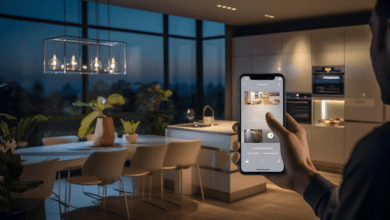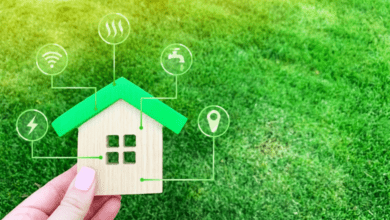Transform Your Home with Smart Home Appliances: Efficiency, Convenience, and Savings

In the rapidly evolving landscape of home appliances, smart technology has emerged as a game-changer, offering homeowners unprecedented levels of efficiency, convenience, and savings. From kitchen gadgets to household essentials, smart home appliances are revolutionizing the way we live, providing innovative solutions to everyday tasks while reducing energy consumption and streamlining household routines. In this comprehensive guide, we’ll explore the benefits of smart home appliances, highlight popular options available on the market, and offer practical tips for integrating smart technology into your home.
The Rise of Smart Home Appliances
With the advent of the Internet of Things (IoT) and advances in connectivity, traditional home appliances have undergone a remarkable transformation, giving rise to a new generation of smart devices. Smart home appliances are equipped with sensors, processors, and wireless connectivity, enabling them to communicate with users, other devices, and cloud-based services. Whether it’s a refrigerator that sends alerts when groceries are running low or a thermostat that learns your temperature preferences, smart appliances offer unprecedented levels of automation, personalization, and control.
Benefits of Smart Home Appliances
The benefits of smart home appliances are manifold, encompassing various aspects of modern living. Here are some of the key advantages:
1. Energy Efficiency:
Smart home appliances are designed to optimize energy usage, helping homeowners reduce their carbon footprint and lower utility bills. By leveraging features such as programmable settings, energy monitoring, and adaptive algorithms, smart appliances minimize energy waste and maximize efficiency, ultimately leading to long-term savings on electricity, gas, and water bills.
2. Convenience:
One of the primary appeals of smart home appliances is their ability to simplify household tasks and streamline daily routines. Whether it’s controlling appliances remotely via smartphone apps, receiving notifications and alerts, or automating repetitive tasks, smart appliances empower homeowners to manage their homes more efficiently and effortlessly, freeing up time for other activities and pursuits.
3. Connectivity:
Smart home appliances are interconnected, allowing them to communicate and collaborate with each other to enhance functionality and performance. This interconnectedness enables seamless integration between different devices and systems, creating a cohesive smart home ecosystem where appliances work together harmoniously to optimize comfort, convenience, and efficiency.
4. Personalization:
Smart home appliances offer a high degree of personalization, allowing users to tailor settings and preferences to suit their individual needs and preferences. Whether it’s adjusting temperature settings, customizing cooking presets, or creating personalized schedules, smart appliances empower users to personalize their home environment to align with their lifestyle and preferences.
5. Enhanced Functionality:
Smart home appliances often come equipped with advanced features and capabilities that go beyond those of traditional appliances. Whether it’s voice control, artificial intelligence, or machine learning algorithms, smart appliances leverage cutting-edge technologies to deliver enhanced functionality, performance, and user experience, elevating the standard of modern living.
Popular Types of Smart Home Appliances
The market for smart home appliances is vast and diverse, encompassing a wide range of categories and products. Here are some popular types of smart home appliances:
1. Smart Thermostats:
Smart thermostats are designed to optimize heating and cooling systems, helping homeowners maintain comfortable indoor temperatures while minimizing energy consumption. With features such as programmable schedules, remote access, and energy usage insights, smart thermostats offer unprecedented control over home climate settings, leading to energy savings and improved comfort.
2. Smart Lighting Systems:
Smart lighting systems allow homeowners to control and automate their lighting fixtures, creating customized lighting environments tailored to their preferences and activities. Whether it’s adjusting brightness levels, changing colors, or scheduling lighting scenes, smart lighting systems offer flexibility, convenience, and energy efficiency, enhancing the ambiance and functionality of any space.
3. Smart Security Systems:
Smart security systems provide advanced protection against intruders, burglaries, and other security threats, offering homeowners peace of mind and confidence in their home’s safety. With features such as motion detection, video surveillance, and smartphone alerts, smart security systems enable remote monitoring and control, allowing users to keep an eye on their home from anywhere, anytime.
4. Smart Kitchen Appliances:
Smart kitchen appliances, such as refrigerators, ovens, and dishwashers, revolutionize meal preparation and cooking, offering innovative features and capabilities that make cooking easier, faster, and more enjoyable. Whether it’s pre-programmed cooking presets, recipe suggestions, or remote monitoring, smart kitchen appliances empower users to create delicious meals with minimal effort and maximum convenience.
5. Smart Home Assistants:
Smart home assistants, such as Amazon Alexa, Google Assistant, and Apple HomeKit, serve as central hubs for controlling and coordinating smart home devices and services. With voice commands and intuitive interfaces, smart home assistants enable seamless integration and interaction between different devices, allowing users to control their entire smart home ecosystem with simple voice commands or taps on a smartphone.
Tips for Integrating Smart Home Appliances
Integrating smart home appliances into your home is a straightforward process that requires careful planning and consideration. Here are some tips to help you get started:
1. Assess Your Needs:
Begin by identifying areas of your home where smart technology can enhance functionality, efficiency, and convenience. Whether it’s upgrading existing appliances or adding new ones, prioritize areas that align with your lifestyle and preferences, such as the kitchen, living room, bedroom, or home office.
2. Research Options:
Research different brands, models, and features to find smart home appliances that meet your specific requirements and budget. Consider factors such as compatibility, connectivity, functionality, and user reviews when evaluating options, and choose appliances that offer the features and performance you desire.
3. Plan Your Budget:
Determine your budget for smart home appliances and allocate funds accordingly to ensure you can afford the appliances you need without overspending. Keep in mind that while smart appliances may have a higher upfront cost compared to traditional models, the long-term savings and benefits often justify the investment.
4. Consider Integration:
Consider how smart home appliances will integrate with existing devices and systems in your home, such as Wi-Fi networks, smart home assistants, and other smart devices. Ensure compatibility and seamless integration between different devices to create a cohesive smart home ecosystem that works harmoniously together.
5. Installation and Setup:
Follow manufacturer guidelines and instructions for installation and setup to ensure proper functioning and optimal performance of your smart home appliances. Pay attention to details such as Wi-Fi connectivity, firmware updates, and user settings to maximize efficiency and usability.
Conclusion
In conclusion, smart home appliances offer a myriad of benefits for homeowners seeking to enhance efficiency, convenience, and savings in their homes. Whether it’s reducing energy consumption, simplifying household tasks, or creating personalized environments, smart appliances empower users to transform their homes into modern, connected, and intelligent living spaces. By embracing smart technology and integrating smart home appliances into their homes, homeowners can enjoy a higher quality of life, greater comfort, and peace of mind knowing they’re maximizing efficiency, minimizing waste, and optimizing their home environment for modern living.



